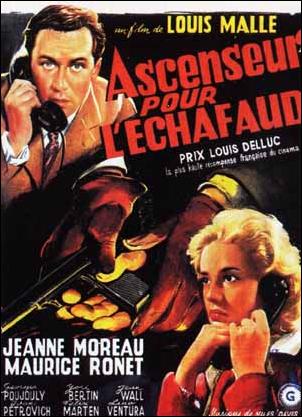Back to Inner Sleeve - the Rat Records blog>
Tune into the Pictures Part 4: Dead Man in the Elevator

Our final tune into the pictures takes it all back to where it belongs. We gave you the detail on the history of sound on film, felt the heavy axe of John Carpenter and then were bitten by a serious Goblin.You'll remember the core concept that films were never, really, silent. Music was played, sound and magic were created on the spot. And a big bunch of that was based on improvisation.Jazz, as in real JAZZ, not coffee table jizz or nostalgia novelty jive, is based, like Bach, on riffing, feeling and thinking around fellow artists, in real time. Unless you are going to one of those disgusting singalongasemenstain showings of a musical these days only the crazy and rude speak during a film. But deep in your mind, a symphony of feelings is being directed. Live. And Miles Davis gave that Sound.Ascenseur pour l'�chafaud, a 1958 film noir released in the US as "Elevator to the gallows" and in the UK as "Lift to the scaffold" was directed by Louis Malle when he was relevant. And is the first great performance of Jeanne Moreau. See it now, on the biggest screen possible.The film is based around the noir staples of love, desperation, greed and the evil jokes fortune plays on us all. Tension and despair abound like a hail of black ice. Powering it all along is a pitch black sonic soul.Miles Davis is the Bach of the 20th Century. He happened to be in Paris in the winter of 1957, because French people tend to love great art rather more than those across the ocean. Miles had a residency at Club Saint-Germain, and Malle's assistant, the tasteful Jean-Paul Rappeneau realised that a big slug of jazz would hippen up the flick. Miles met Louis, and then had a private screening of the film before agreeing to score it. He came up with a few harmonic fragments, and then brought his sidemen along with no other explanation other than a summary of the plot. They then began to improvise while loops of the bits of the film needing a score were projected in the background.The result, released in various forms but often just as "Jazz Track", needs to be experienced immediately.37 years later into our musical mess age, another, far more visionary director created one of the greatest and most slept on films of all time. Dead Man is Jim Jarmusch's finest achievement by far. Inspired by the furthest out and coolest Italian co-produced westerns, especially Sergio Corbucci's "The Great Silence" and Giuilo Testi's "Django Kill. If you live, Shoot!", where it's never clear who is alive or dead, why and the Wild West is a savage hell rather than a postcard, you need to experience it at least twice a year in the best way possible.For the soundtrack, Jim called in a friend and legend. Neil Young. Now while other than "Harvest Moon" and a few other flashes of fantastic, Neil Young's output post 1979 has been pretty spotty, but you can't find a more earnest artist. He took the Miles Davis Paris approach to a new extreme, bleak and beautiful. Alone in the dark, watching the film itself, Neil Young improvised a score mainly on electric guitar but with some dashes of acoustic, organ and piano.This intimacy raises the effort up beyond any other soundtrack into the individual silver halide grains of the FILM itself. There is no separation, its not even fusion. It is like blood in flesh. Water in an ocean."Indie" movie mogul Harvey Weinstein, whose not very loving industry nickname remains "Harvey Scissorhands" for his insistence on re-editing films he has financed, often without the knowledge of the original director, who would then see an American VHS of their work chopped and changed and minced into the Pretentious Mainstream Product Harvey slings, put up the cash. The man behind "Madonna: Truth or Dare" is a decent businessman, but no artist.Harvey never liked Jim much, and probably just assumed that he could cash in on a reputation for reasonably hip Eurofriendly cool stuff to make a quick buck with a quirky Western starring teen pinup Johnny Depp. Jim got $9m to make the picture. While that would not pay for the coffee of most Hollywood hurl, it is the most cash he will ever get. And every penny can be felt. Sadly, Harvey didn't like it. 'Confusing, downbeat. And what's that weird sound stuff? Some old hippie chewing a guitar or killing a cat? Don't get it.' Jim's contract gave him final cut, and he would not touch a second. Harvey wanted to punish him more than make the money back. So very few prints were made, little marketing was done and it was ages before it ever appeared on video. Even now most video editions of it are cheap and loveless, and few copies of the score were made at the time. Only those that Knew, Knew.That's probably why our own Philippe has one of the only real rare vinyl copies of the soundtrack. And why he is one of the luckiest, coolest men on Earth.
Looking for a gem of wisdom and insight from an older article?
Search the inner sleeve
Sell Your Records & CDs To Us
It's quick, it's easy.
We're friendly, fair and knowledgeable, and we collect nationwide.
"I never expected to enjoy selling my record collection, but you made the process a remarkably upbeat one."
